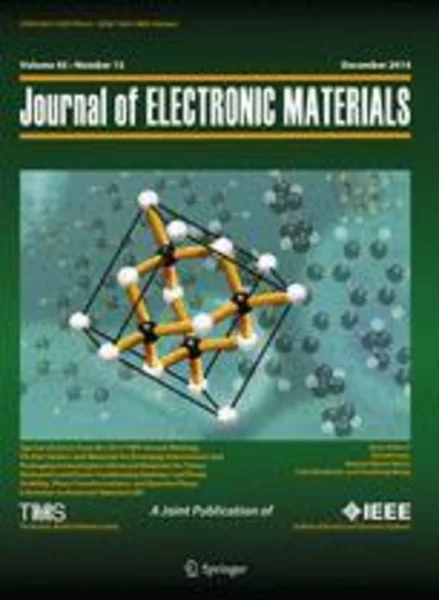-
effect of ag content and the minor alloying element fe on the mechanical properties and microstructural stability of sn-ag-cu solder alloy under high-temperature annealing
جزئیات بیشتر مقاله- تاریخ ارائه: 1392/07/24
- تاریخ انتشار در تی پی بین: 1392/07/24
- تعداد بازدید: 826
- تعداد پرسش و پاسخ ها: 0
- شماره تماس دبیرخانه رویداد: -
this study compares the high-ag-content sn-3ag-0.5cu with the low- ag-content sn-1ag-0.5cu solder alloy and the three quaternary solder alloys sn-1ag-0.5cu-0.1fe, sn-1ag-0.5cu-0.3fe, and sn-1ag-0.5cu-0.5fe to understand the beneficial effects of fe on the microstructural stability, mechanical properties, and thermal behavior of the low-ag-content sn-1ag-0.5cu solder alloy. the results indicate that the sn-3ag-0.5cu solder alloy possesses small primary β-sn dendrites and wide interdendritic regions consisting of a large number of fine ag3sn intermetallic compound (imc) particles. however, the sn-1ag-0.5cu solder alloy possesses large primary β-sn dendrites and narrow interdendritic regions of sparsely distributed ag3sn imc particles. the fe-bearing sac105 solder alloys possess large primary β-sn dendrites and narrow interdendritic regions of sparsely distributed ag3sn imc particles containing a small amount of fe. moreover, the addition of fe leads to the formation of large circular fesn2 imc particles located in the interdendritic regions. on the one hand, tensile tests indicate that the elastic modulus, yield strength, and ultimate tensile strength (uts) increase with increasing ag content. on the other hand, increasing the ag content reduces the total elongation. the addition of fe decreases the elastic modulus, yield strength, and uts, while the total elongation is still maintained at the sn-1ag-0.5cu level. the effect of aging on the mechanical behavior was studied. after 720 h and 24 h of aging at 100°c and 180°c, respectively, the sn-1ag-0.5cu solder alloy experienced a large degradation in its mechanical properties after both of the aging conditions, whereas the mechanical properties of the sn-3ag-0.5cu solder alloy degraded more dramatically after 24 h of aging at 180°c. however, the fe-bearing sac105 solder alloys exhibited only slight changes in their mechanical properties after both aging procedures. the inclusion of fe in the ag3sn imc particles suppresses their imc coarsening, which stabilizes the mechanical properties of the fe-bearing sac105 solder alloys after aging. the results from differential scanning calorimetry (dsc) tests indicate that the addition of fe has a negligible effect on the melting behavior. however, the addition of fe significantly reduces the solidification onset temperature and consequently increases the degree of undercooling. in addition, fracture surface analysis indicates that the addition of fe to the sn-1ag-0.5cu alloy does not affect the mode of fracture, and all tested alloys exhibited large ductile dimples on the fracture surface.
مقالات جدیدترین رویدادها
-
استفاده از تحلیل اهمیت-عملکرد در ارائه الگوی مدیریت خلاقیت سازمانی و ارائه راهکار جهت بهبود
-
بررسی تاثیر ارزش وجوه نقد مازاد بر ساختار سرمایه شرکت های پذیرفته شده در بورس اوراق بهادار تهران
-
بررسی تأثیر سطح افشای ریسک بر قرارداد بدهی شرکت های پذیرفته شده در بورس اوراق بهادار تهران
-
بررسی تأثیر رتبه بندی اعتباری مبتنی بر مدل امتیاز بازار نوظهور بر نقد شوندگی سهام با تأکید بر خصوصی سازی شرکت ها
-
تأثیر آمیخته بازاریابی پوشاک ایرانی بر تصویر ذهنی مشتری پوشاک ایرانی (هاکوپیان)
-
بررسی ارزیابی کارایی مصرف انرژی از نظر سوخت و برق ایستگاه های پمپاژ آبیاری بارانی مطالعه موردی
-
بررسی و مقایسه ی معماری های امنیتی رایانش ابری در راستای ارائه راهکارهایی جهت توسعه سازمان های امنیتی
-
مطالعه آزمایشگاهی رفتار برشی اتصالات پیچی در سازه های فولادی سرد نورد شده
-
بررسی تطبیقی عوامل موثر بر مدیریت پورتفولیوی پروژه ها مطالعه موردی: شرکت مهندسین مشاور آمایش و توسعه شرق و شرکت مهندسین مشاور طوس آب
-
use of ultrasonic waves in sub-cooled boiling
مقالات جدیدترین ژورنال ها
-
مدیریت و بررسی افسردگی دانش آموزان دختر مقطع متوسطه دوم در دروان کرونا در شهرستان دزفول
-
مدیریت و بررسی خرد سیاسی در اندیشه ی فردوسی در ادب ایران
-
واکاوی و مدیریت توصیفی قلمدان(جاکلیدی)ضریح در موزه آستان قدس رضوی
-
بررسی تاثیر خلاقیت، دانش و انگیزه کارکنان بر پیشنهادات نوآورانه کارکنان ( مورد مطالعه: هتل های 3 و 4 ستاره استان کرمان)
-
بررسی تاثیر کیفیت سیستم های اطلاعاتی بر تصمیم گیری موفق در شرکتهای تولیدی استان اصفهان (مورد مطالعه: مدیران شرکتهای تولیدی استان اصفهان)
-
چگونگی مدیریت مغالطه توسل به منبع ناشناس در سازمان ها
-
بررسی میزان کاربرد مدل های طراحی آموزشی در ارزیابی دوره های آموزش الکترونیک در نظام آموزش عالی ایران
-
بررسی نقش تعدیل گر ارتباطات سیاسی بر رابطه بین ریسک سقوط قیمت سهام و هزینه سرمایه در شرکت های پذیرفته شده در بورس اوراق بهادار تهران
-
cost and time interaction behavior on construction materials procurement and execution processes in infrastructure projects
-
the impact of information technology on corporate communications department of the department of education in district 3 of tabriz




سوال خود را در مورد این مقاله مطرح نمایید :